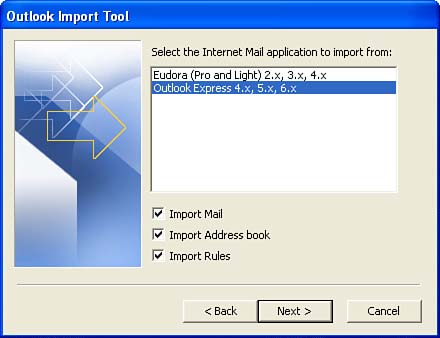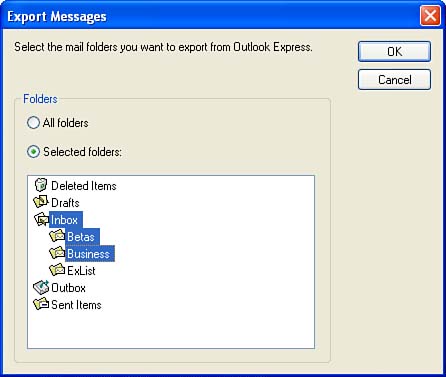Migrating Accounts and Settings
| After the Office or Outlook installation is complete and you open Outlook for the first time, it'll ask whether you want to import the email accounts it found. If you choose Yes, your account settings are imported to Outlook. If you choose No, you can import the account settings at a later date, using File, Import and Export.
When you choose to import your Outlook Express accounts, Outlook imports your account settings, email, and rules into Outlook.
After the import is completed, a dialog asks whether you want to make Outlook your default email client. Although Outlook works just fine for most things when Outlook Express is the default email client, if you want Outlook to handle mailto URLs or use Word's mail merge, you must set it as the default.
If you chose No or imported only one account when you first opened Outlook and now want to import the other account settings, use Outlook's F ile, Impor t and Export menu selection to open the Import and Export Wizard.
Choose Import Internet Mail and Addresses on the Import and Export Wizard to open the Outlook Import tool (see Figure 24.1). From this screen, you can choose whether to import your email, address book, or rules from Outlook Express to Outlook. Figure 24.1. You can use the Import and Export Wizard to import your Outlook Express account settings or to import just your email, address book, and rules. To confirm that the account settings that Outlook imports are correct:
When importing contacts, you can let Outlook check for duplicates as it imports or import all contacts, which might result in duplicate contacts. In some cases, you might choose to import duplicates and compare and delete the duplicates yourself. The easiest way to know which items are new and potentially duplicated is to add the Modified Date field to your view. All imported items have a current modified date, so you can use a custom view to group or sort duplicates together and then use the Modified Date field to identify the new contacts. To add the Modified Date field to your Outlook view:
Moving Email to OutlookExporting messages from Outlook Express to Outlook gives you the option to choose the folders that you want to copy to Outlook. Access the Export dialog from Outlook Express's F ile, E xport, M essages menu choice. Choose A ll Folders or S elected Folders. If you choose Selected Folders, hold down the Ctrl key to select multiple folders (see Figure 24.2). Figure 24.2. Use the Export Messages dialog to export messages from Outlook Express to Outlook. When the export is initiated from Outlook Express, you can select the folders you want to include in the export. With previous versions of Outlook, importing into Outlook using Outlook's File, Import and Export menu selection often resulted in the import date replacing the received date. Exporting from Outlook Express to Outlook retained the correct dates. Although this bug appears to be fixed in Outlook 2003, if you use Import in Outlook and the import date is displayed instead of the correct received date, export from Outlook Express instead.
Task: Move Accounts and Messages from Outlook Express to OutlookYou don't need to re-create your accounts in Outlook. You can copy many of the settings to Outlook and save yourself a lot of time and aggravation:
Follow the steps in the Import Wizard screens and your account information will be imported into Outlook. |
EAN: 2147483647
Pages: 228
- An Emerging Strategy for E-Business IT Governance
- Linking the IT Balanced Scorecard to the Business Objectives at a Major Canadian Financial Group
- Technical Issues Related to IT Governance Tactics: Product Metrics, Measurements and Process Control
- Governance in IT Outsourcing Partnerships
- The Evolution of IT Governance at NB Power

